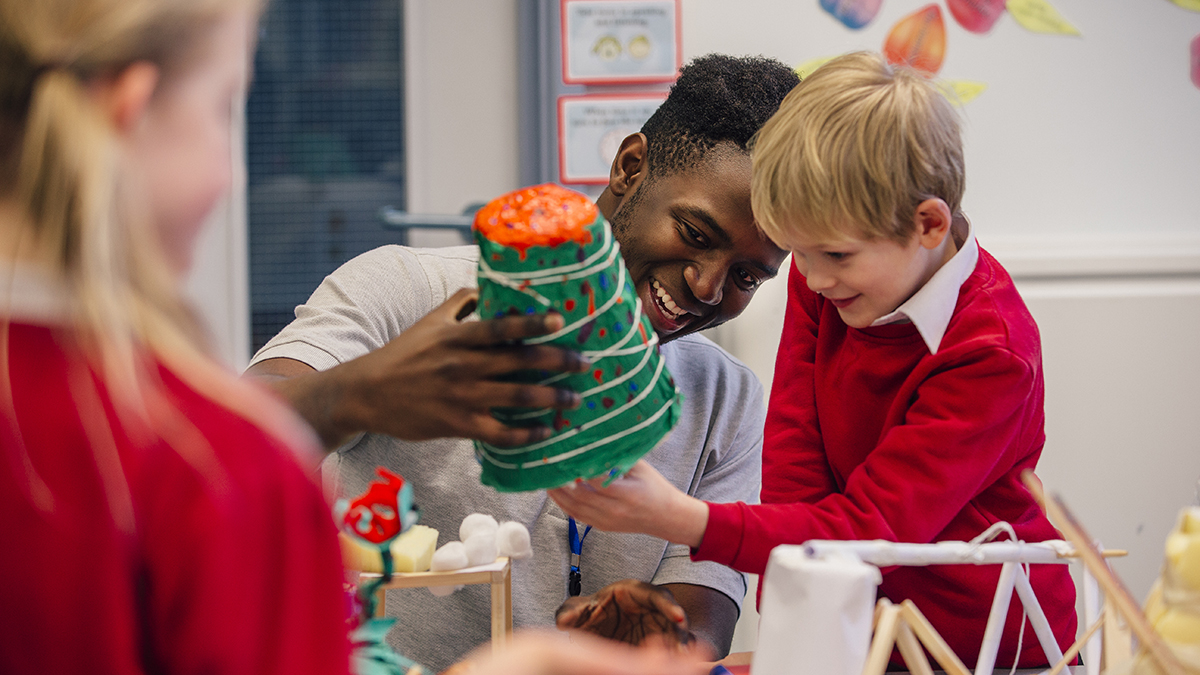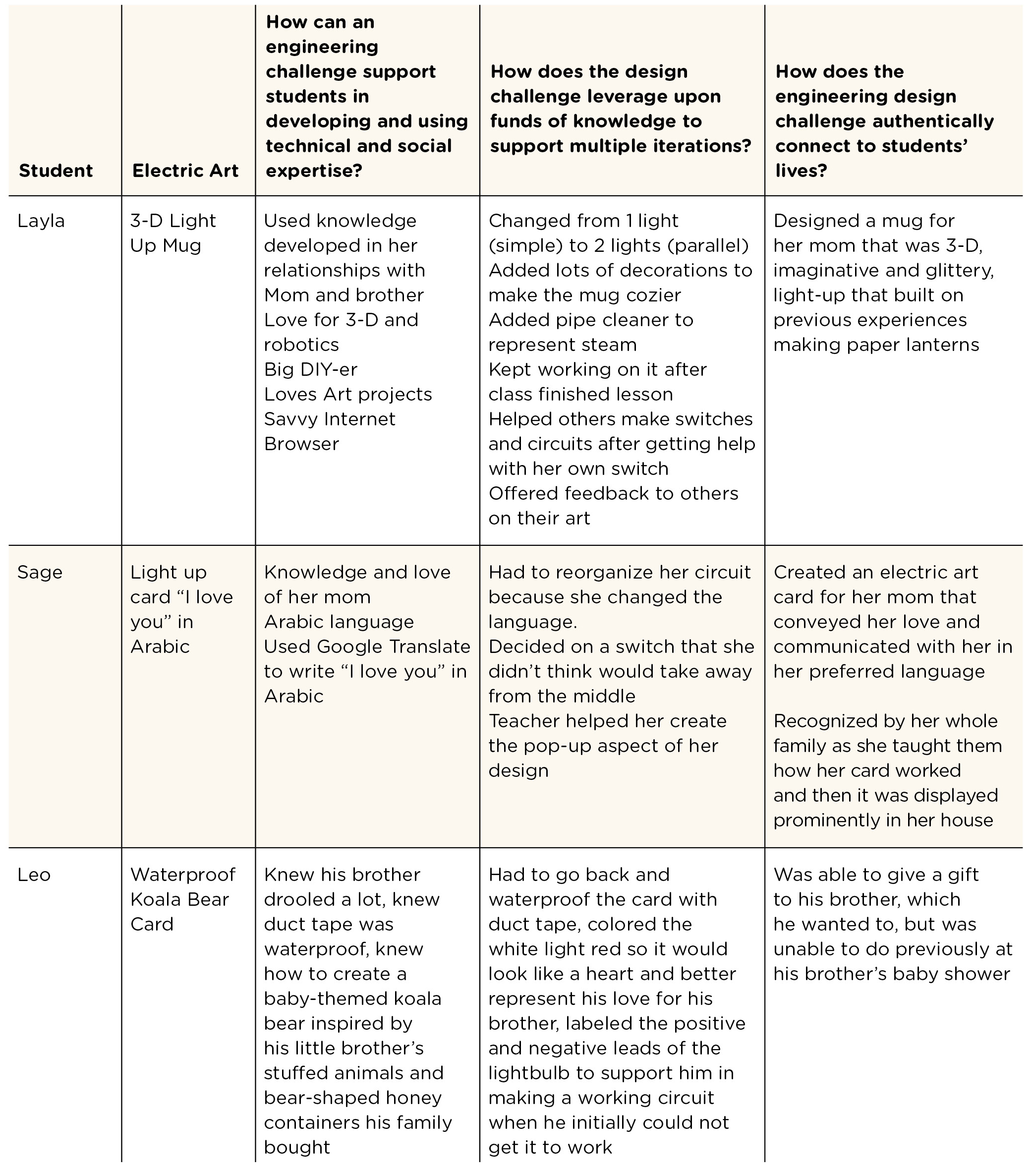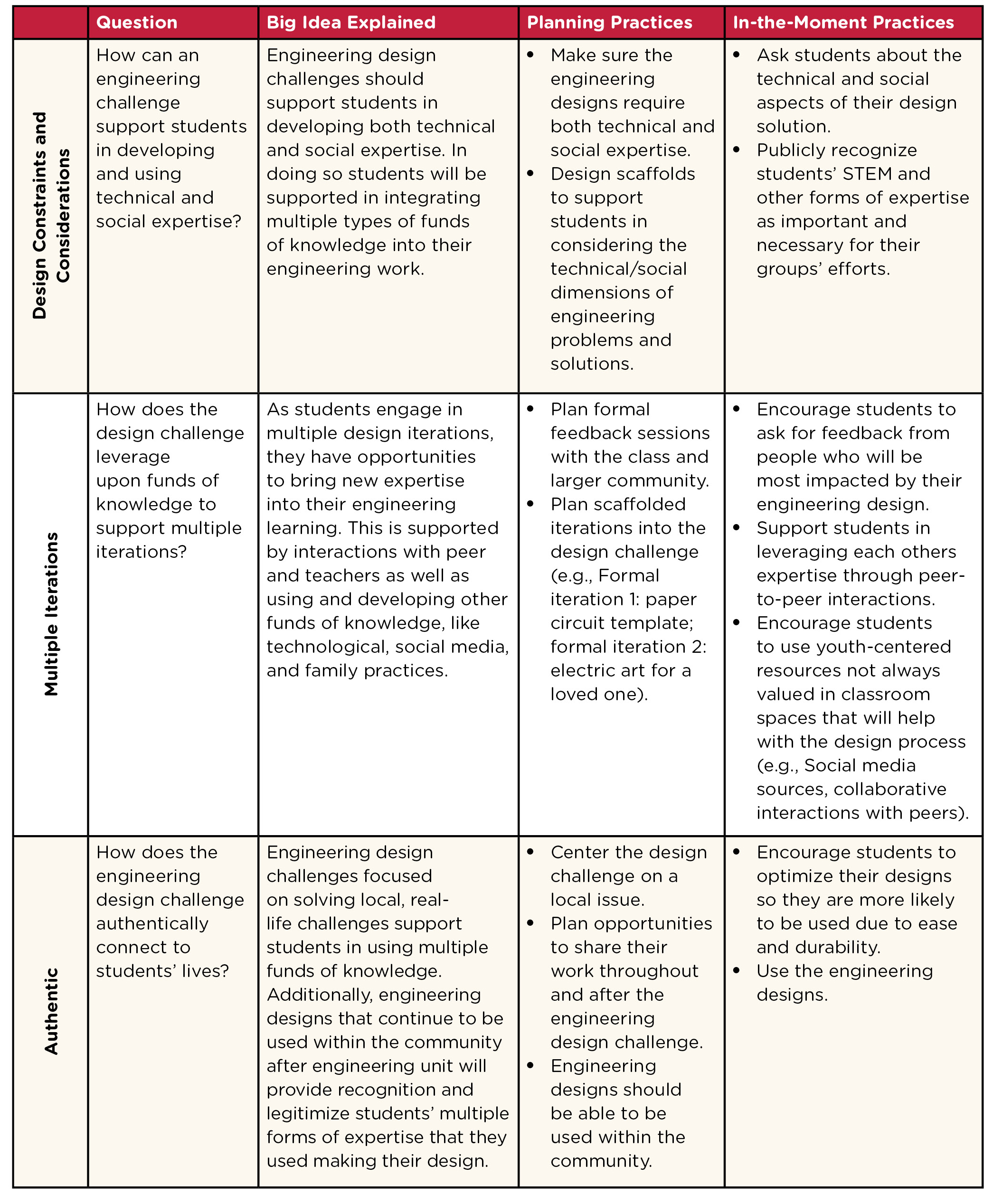feature
An Engineering Funds of Knowledge Framework
An approach to support teachers in leveraging students’ personal knowledge, cultural expertise, and assets in engineering
Science and Children—July/August 2021 (Volume 58, Issue 6)
By Kathleen Schenkel, Angela Calabrese Barton, Chelsey Wiersma, Olivia Eiden, Edna Tan and Scott Calabrese Barton

Layla created a three-dimensional, light-up paper lantern–style mug as a gift for her mother during an engineering unit focused on energy systems. To light her mug, Layla designed and built a parallel circuit using two LED lights, copper tape, and a coin cell battery. The switch, a movable flap between the battery and copper tape, was decorated with a bow.
Layla drew upon many personal and cultural resources, including her passion for making and crafting. She explored pictures of three-dimensional lanterns and cards on Google Images and drew from her prior positive experiences making three-dimensional and tech-centric projects like a working robot with her brother. In addition to drawing on resources to successfully engineer circuits in a three-dimensional way, the electric art templates provided in the engineering unit informed her circuit design. Decorations to increase “coziness” were carefully added, including gluing flowers on the mug’s base so “it can look like it’s just wonderful imaginary world of yours” and a curling pipe cleaner to represent a steaming beverage. Her initial design with only one LED was not “cozy” enough. So even though “it took a long time to do the circuit” she added a second light, requiring her to switch from a simple circuit to a parallel circuit.
Layla felt proud as she shared, “I feel like I can teach, and if someone asks me about LED lights, series circuits, simple circuits, or parallel circuits, I can help them.” She predicted that her mom would “think that I am very creative, very smart, and very thoughtful that I did this for her. And she’s going to think I’m successful.”
Layla’s experience illustrates how having opportunities to leverage her various Funds of Knowledge (FoK) while making a light-up mug helped her engage deeply in STEM knowledge and practices, leading to feelings of accomplishment. FoK are the various forms of expertise and practices youth develop over time in families and communities, and that can be strategically leveraged for learning and participation in school settings (Llopart and Esteban-Guitart 2018). Family and community (e.g., parents’ work in and outside the home, travel, and environmental and health concerns); peers (e.g., formal and informal group activities); and popular culture (e.g., TV, music, print, and social media) are some categories of FoK (Calabrese Barton and Tan 2009). Supporting students in using their FoK in engineering is an asset-based approach to supporting STEM learning and provides opportunities to connect school and community. By community, we refer to the people and places that students interact with on a regular basis.
When FoK are strategically tapped into, students have opportunities to engage with knowledge that is familiar to them as a foundation for more sophisticated content-based learning (Birmingham et al. 2017; Civil 2018). Layla’s mug highlights this point. Layla’s FoK—developed with her brother making three-dimensional objects, crafting at home, using technology to support her craft and technical efforts as well as learning circuits in school—supported her engagement in the electric art project and her efforts at optimizing it.
It is well established that drawing upon students’ FoK supports powerful learning outcomes, especially for youth whose life experiences are not always valued in dominant classroom spaces. Yet, teachers can struggle to find ways to do so (Gonzalez, Moll, and Amanti 2005). In this article, we introduce an engineering FoK framework to better support teachers in positioning students to leverage their FoK in engineering. The framework (Figure 1) focuses on three aspects of engineering design challenges. Design challenges should (1) require both technical and social expertise, (2) support multiple design iterations within the design challenge, and (3) connect authentically to students’ lives. Table 1 shows how the engineering FoK framework principles are connected. Below we highlight these three principles through guiding questions and explanations to support teachers in planning and in-the-moment strategies that leverage students’ FoK in engineering.


How can an engineering challenge support students in developing and using technical and social expertise?
Engineering design challenges should support students’ leveraging of multiple funds of knowledge. The first key framework principle is that design constraints should require both technical and social expertise. Technical expertise is often grounded in STEM knowledge, while social expertise can be built from drawing on students’ multiple FoK. Such a dual focus can support students in developing new forms of expertise that combine STEM knowledge with FoK. This makes developing one’s expertise in science more authentic and motivating. Within the FoK engineering framework, it is important for students to be able to use and further develop multiple types of FoK, related (but not limited) to STEM expertise and family/community expertise.
To plan ahead, teachers should consider what expertise students might be able to tap into because of who they are and where they have grown up that could be useful in an engineering design challenge. During class interactions, teachers can challenge students to address technical and social aspects of the design challenge and their solution. Additionally, they can recognize and encourage students to use multiple resources to develop and leverage the different forms of expertise that they need to complete the engineering design challenge. During the design process, teachers can observe how students use multiple funds of knowledge in their engineering design work. After students complete the engineering projects, teachers can ask students what different types of knowledge helped them be successful in the design task. Mrs. L used an interview rubric to elicit students’ thinking (see Supplemental Resources).
Layla’s FoK included her expertise in crafting and robotics, developed at home with her mom and brother. Layla brought in her artistic talent, internet searching expertise, love of robotics, and desire to make a gift for her mother to engage deeply in learning about energy transformations and hands-on engineering design. Layla combined her developing knowledge and practices in science with her expertise on what might make a light-up mug cozy. Layla brought her multiple talents into the design challenge that emphasized incorporating a working circuit into art to make a gift for a loved one. If Layla’s teacher, Mrs. L, only emphasized the science expertise required, she would not have been supported in using such a wide range of expertise. Mrs. L, through an informal interview, asked Layla what expertise she used to make her card and by looking at the card she also could see multiple forms of expertise used. Creating space for all of these forms of expertise through a design challenge that required both technical and social expertise was important to both her success and motivation.

How does the design challenge leverage funds of knowledge to support multiple iterations?
Through engaging students in multiple design iterations, teachers create sustained opportunities for students to deepen STEM understanding while integrating students’ care for and knowledge about loved ones. Through multiple design iterations, students have opportunities to bring new expertise into their engineering learning. During these design iterations, teachers foster opportunities for students to share their FoK with others, leading to increased recognition of student expertise as well as supporting design optimization. This helps students to see themselves as capable and confident in science while expanding and strengthening their own engineering expertise. To ensure that students are moving through multiple design iterations, teachers should ask students what changes they have made to their engineering designs and why throughout the engineering cycle.
Teachers can schedule formal feedback sessions with the class and larger community at multiple points throughout the unit. Additionally, they can scaffold iterations into the design challenge (e.g., Formal iteration 1: Paper circuit template; Formal iteration 2: Electric art for a loved one). In-the-moment strategies such as encouraging students to immediately ask for feedback from their peers or others that will be impacted by their engineering design solutions will support flexibility in the engineering design cycle. This flexibility will allow for students to engage in multiple engineering design iterations throughout an engineering challenge.
Layla went through many iterations before having a working three-dimensional light-up mug. Each iteration was prompted by challenges that advanced her sense-making. When she thought her mug needed to be more “cozy,” she added a second LED light, prompting further circuitry explorations, plus additional crafting features, such as the curling pipe cleaner to represent the steaming hot beverage. These iterations invited Layla to use multiple types of FoK. To evaluate Layla’s various design iterations, Mrs. L asked her to explain the process she undertook making the electric art and then asked her how each change she made deepened her expertise using the post-electric art interview rubric.
How does the engineering design challenge authentically connect to students’ lives?
Engineering design challenges focused on solving local, real-life challenges support students in using multiple FoK. Engineering designs that continue to be used within the community provide continued recognition and legitimization of students’ wide-ranging expertise. Teachers planning authentic design challenges should ask where, when, and how the engineering design solutions can be used by the students and/or their community.
When planning an authentic design challenge, teachers should ask how they could connect disciplinary core ideas and engineering practices to local issues. Asking students for ideas can help with this brainstorming, and teachers should encourage students to optimize their designs for ease of use and durability. If the engineering designs stay in the classroom, teachers should ensure that they are regularly used. This recognizes students’ multiple FoK and shows that their engineering work matters.

Consider how the electric art challenge was authentic. Layla was able to create something that mattered to her mom and herself. The light-up mug was used for a long time after the energy engineering unit was over. Mrs. L was able to evaluate if the design challenge authentically connected to Layla’s life when she saw that the card lit up and read Layla’s response to this question, “Why do you think they (the recipient of your card) will like your electric art?” This recognized Layla’s multiple FoK and legitimized her engineering efforts.
Relationship Between the Three Guiding Principles
The three principles of the engineering funds of knowledge framework (design challenges that require technical and social expertise, multiple iterations, and are authentic) build on and support each other. An authentic design task requires students to develop and use social and technical expertise and engage in multiple iterations to complete the design task in ways that matter beyond learning STEM knowledge. When engaging in pedagogical planning, teachers should consider these guiding principles as integrated rather than separate. See Table 2 for planning and in-the-moment strategies to enact this framework.

Applying the Framework
We highlight the engineering FoK framework through an electric art engineering design challenge because it is popular and used across multiple grade levels (3–6). However, the framework is applicable to any engineering unit. The electric art design challenge is meant to support students’ sense-making of core disciplinary ideas on energy systems (e.g., power requirements) and transformations (e.g., electrical to light energy) and the two engineering practices, defining a problem and designing a solution. Rather than only asking students to make and test different circuit types and draw model-based explanations for how and why the circuit types work, students leverage these insights toward making a light-up gift for a loved one, limited to the following materials: one 3-volt battery, up to two 5mm led lights, copper tape, cardstock, and other common classroom craft supplies. While this electric art design challenge is not new, the ways in which the teacher used the framework to support her students in leveraging their FoK, while delving deeply into the engineering, highlights the transformative outcomes of this approach. Templates, supply information, and student handouts are available for download for this lesson (see Supplemental Resources).
The engineering FoK framework guided two iterative, electric art design cycles. Students decided who they were making their electric art for and how to design it both socially (artistically) and technically (circuit-wise) to celebrate that person. They accomplished this through two cycles of prototyping. In the first cycle, students modeled three types of circuits (simple, parallel, and series), analyzing and developing evidenced-based explanations for the different advantages and constraints of each circuit type regarding power requirements. This is often where circuitry and energy lessons stop.
The students then used this expertise in a way that mattered to them as they designed their own electric art. During this second prototyping cycle, students leveraged personal, family, and community resources in personalizing their electric art. Students were positioned as experts as they helped peers make their cards. Their hybrid-expertise involved helping peers troubleshoot how to make their circuits and switches work within their desired social specifications of their designs, or to modify their specifications as they moved through multiple iterations. The teacher encouraged peer-help and used student-made cards as resources for struggling groups. When the students delivered their electric art cards to loved ones, they were further positioned as experts, as they often explained how circuits worked. Teachers can assess if their implementation of the electric art lessons and other units supported students in deepening their expertise by asking informal questions across the design challenge, observing the students’ actual engineering design, and interviewing students. This multipronged assessment approach can help teachers see if and how they supported students in incorporating their multiple funds of knowledge in the engineering process.
Below we explore how our framework supported students in using their FoK and supported transformative outcomes.
Vignette: Sage – Learning to see herself as a science person
“It says I am determined. I can push through, and that I care about people. I am creative and smart.” —Sage, describing what the electric art card said about herself.
Sage describes herself as a “young, smart girl, who likes to be creative. I’m sweet and I just want the best for everyone.” Everyone who knows Sage agrees. This exceptional care for others was shown in her electric art card for her mother designed to say “I love you,” embellished with a single light in the “o” of “love.”
When she started creating the circuit, Sage realized her mother only spoke and read in Arabic. She decided to write “I love you” in Arabic, a design iteration to make the card more meaningful to her mother.
Sage utilized multiple resources in the process. While Sage speaks Arabic at home, she has not yet learned to read or write Arabic, leading her to use Google Translate to look up how to write “I love you” in Arabic. With the language change, Sage had to change her design (the light could no longer go in the “o” in “love”). She also decided to “hide” the circuit on the inside of the card so that she had space to draw a rose (Figure 2).

Through the utilization of FoK and design iterations, Sage developed robust expertise. Sage utilized her knowledge from the electric art lesson, her understanding of her family, and access to technological resources. These factors played into Sage’s learning, making the design challenge more meaningful and memorable. Furthermore, it allowed Sage the opportunity to share her new expertise as she showed love to her mom, explain to her family how the circuit works, and then had her card displayed in her home.
Why Leveraging FoK Matters
Designing engineering challenges that support students in leveraging their FoK supports equity-oriented outcomes that teachers may never expect. Consider Leo, who created a light-up koala bear for his baby brother. He was inspired by his brother’s stuffed animals and his family’s bear-shaped honey containers. He went through multiple design iterations as he worked to make a working circuit that was waterproof because his younger brother drools a lot. He colored the lightbulb red to make it look like a heart, and he wanted the heart to represent his love for his brother. Leo used this engineering challenge as a chance to make something meaningful for his brother, as he had no gift for him at his baby shower. Developing and using their FoK supported Leo, Sage, and Layla as well as over 450 other students we have worked with in successfully making electric art, in deeply engaging in the engineering practices, learning new electricity expertise, and doing something that mattered to their community and themselves.
The engineering FoK framework can be applied to any engineering unit. We offer strategies that can help classroom teachers support students in using their FoK in all engineering units (see Table 2). Utilizing this framework may support more students in having valuable learning experiences like Layla, Sage, and Leo did. ●
Supplemental Resources
Download templates, supply information, student hand-outs, and rubric at https://bit.ly/3cOCQc9.
Kathleen Schenkel (Kschenkel@sdsu.edu) is an assistant professor at San Diego State University in San Diego, California. Angela Calabrese Barton is a professor in the school of education at the Univeristy of Michigan in Ann Arbor. Chelsey Wiersma is a second-grade teacher at Willow Brook Elementary in Saint Louis, Missouri. Olivia Eiden is a kindergarten teacher at H. T. Smith Elementary in Fowlerville, Michigan. Edna Tan is professor of science education at the University of North Carolina at Greensboro. Scott Calabrese Barton is a professor in the school of engineering at Michigan State Univeristy in East Lansing, Michigan.
Engineering STEM Teaching Strategies Elementary


